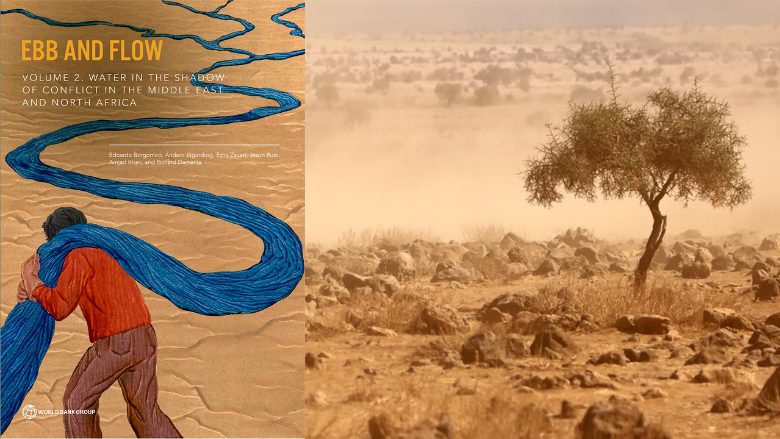
Volume 2 - Water in the Shadow of Conflict (Middle East and North Africa)
Key messages:
Water is more often a victim and casualty of conflict – rather than a primary source of conflict – in the Middle East and North Africa (MENA). Although there have been local instances of strife and displacement in response to water concerns, there is limited evidence that water risks cause large-scale forced displacement or lead directly to conflict.
- The MENA region has the world’s highest levels of forced displacement, with an estimated 7.2 million refugees, of whom 2.7 million are hosted in the region, and 12.4 million internally displaced people fleeing protracted armed conflicts. It is also the world’s most water-scarce region, with over 60% of the population living in areas with high water stress, compared with 35% globally.
- War and unemployment are more influential drivers of migration within MENA than events related to water, such as drought. As the effects of climate change intensify, however, these historical patterns may no longer hold: in areas that lack good governance, climate change could exacerbate vulnerabilities and tensions over water resources, leading to a vicious cycle of water insecurity and fragility.
- Although conflict is an uncertain consequence of water risks, conflicts frequently lead to the targeting and destruction of water infrastructure. Since 2011, there have been at least 180 instances in which water infrastructure was targeted in Gaza, Yemen, Syria and Libya, leaving hundreds of thousands of people without access to water.
- Water is the one of the main vulnerabilities of people displaced by conflict. Access to safe drinking water is a daily struggle for millions of forcibly displaced Iraqis, Libyans, Palestinians, Syrians, Yemenis, and international migrants in the region. These challenges are particularly stark for some of the most vulnerable, such as persons with disability and women, for whom water insecurity has repercussions on mental well-being, exposure to violence and marginalization.
Contrary to popular belief, water risks have historically led more to cooperation than conflict. Within MENA, this is true at the domestic and international level – which involves transboundary rivers and aquifers. As in other parts of the world, long-term exposure to water scarcity strengthens water users’ preference for cooperation.
- Of 975 water events involving international river basins in MENA between 1948 and 2008, 56% were cooperative, 37% conflictive and 8% neutral. Given the number of armed conflicts in the region over that period, the fact that water issues have historically led to cooperation is notable.
- The apparent preference for cooperation should not induce complacency. Some 37% of the events are conflictive. Data suggests that the highest forms of transboundary water cooperation, such as treaties and agreements over shared water resources, are harder to achieve than technical and economic agreements. Formal declarations of war over water have not been registered in the historical database; however, extensive acts of violence related to water have been reported, especially in relation to the Israeli-Palestinian conflict. These include, for example, damage to water supply infrastructure in the May 2021 Gaza conflict (see World Bank Gaza Rapid Damage and Needs Assessment) and other instances reported in academic literature.
- Pre-existing socio-economic grievances in combination with a drought or a water shortage can drive domestic water tensions, especially in the absence of strong institutions. The 2018 water crisis in Basra is a stark reminder of the tensions that can arise following water shortages and declining service quality in the context of protracted armed conflict.
The MENA region urgently needs to move towards water resilience. The protracted displacement crisis and water scarcity calls for a shift from a narrow focus on humanitarian support to policies that promote long-term water security and resilience to future shocks. Given the prolonged nature of conflicts in the region, waiting for their resolution is not a feasible strategy. Development agencies need to join forces with humanitarian actors and ensure that interventions (such as drilling wells) do not undermine long-term sustainability.
-
An integrated framework to respond to water risks in MENA includes a series of building blocks. At the most basic level, in crisis situations, the minimum response includes partnerships with humanitarian and security actors, emergency assistance, and support for continuity of water utilities. Moving into the prevention and development stage includes two additional building blocks:
-
People and area-based interventions to address community grievances in access to water resources, promote labor-intensive watershed restoration, monitor and strengthen infrastructure safety, and help water service providers to win back market share.
-
National interventions to enhance disaster management systems, identify decentralized and low-tech infrastructure solutions, promote cost recovery and efficiency of water utilities, and focus on regulation and monitoring of groundwater abstraction.
-
When working towards this cooperation, policy-makers will likely face trade-offs between short-term, uncoordinated measures to respond to immediate water needs and long-term measures needed to address structural water issues. Failure to recognize and manage these trade-offs can significantly undermine water security prospects for the forcibly displaced and their host communities.
-
Policies to reconstruct national water institutions and infrastructure are likely to fail without the foundations of a renewed social fabric and trust in institutions, which can be achieved through people- and area-based interventions.
This broad policy focus goes well beyond forced displacement and acute crises, and involves seeing water with a new lens across MENA. This is crucial for growth and development in a region that faces the greatest expected economic losses from climate-related water scarcity, estimated at 6–14 percent of GDP by 2050 (see High and Dry: Climate Change, Water, and the Economy, World Bank, 2016).
Press release in Arabic
Key messages in Arabic
"flow" - Google News
August 23, 2021 at 11:25PM
https://ift.tt/3Dhn1WV
Ebb and Flow: Water, Migration, and Development - World Bank Group
"flow" - Google News
https://ift.tt/2Sw6Z5O
https://ift.tt/2zNW3tO
Bagikan Berita Ini














0 Response to "Ebb and Flow: Water, Migration, and Development - World Bank Group"
Post a Comment